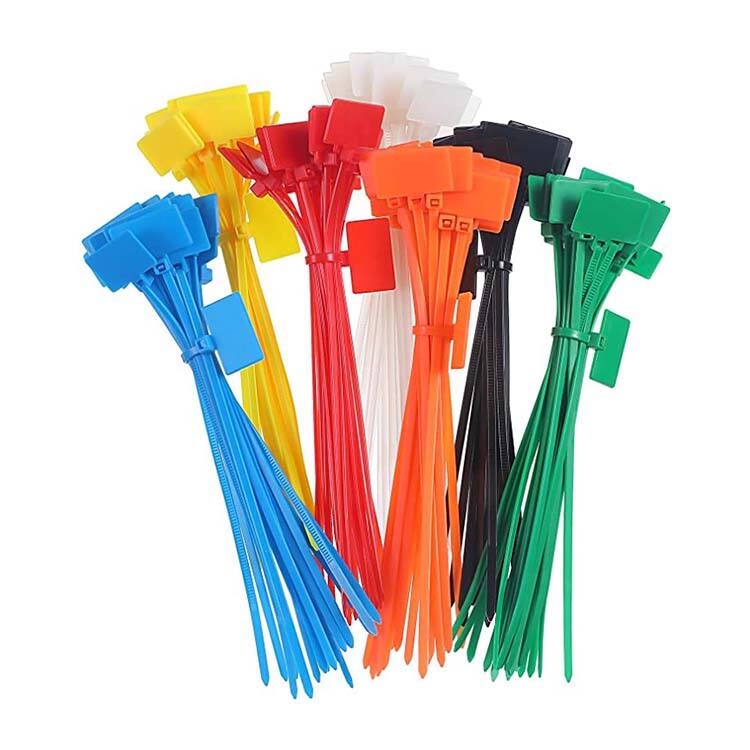Benefits of Stainless Steel Cable Ties for High-Temperature Zones
Stainless steel cable ties work really well in places where temperatures get pretty extreme, like inside factories or around power generation equipment. These ties handle temps anywhere from minus 70 degrees all the way up to over 500 degrees Fahrenheit, so they're great for holding wires and pipes together when things get hot. Standard plastic ties just melt or warp in these situations, but stainless steel versions don't corrode easily and will last much longer even when exposed to harsh conditions. The strength of these metal ties means there's less chance they'll break under pressure, something that matters a lot for safety reasons since a snapped tie could cause dangerous electrical problems. For anyone dealing with wiring in high heat environments, investing in stainless steel cable ties is definitely worth considering.
Nylon Cable Ties in Electrical Panels: Compliance with NEC Standards
Nylon cable ties are commonly used in electrical panels because they meet NEC standards, something that's really important for keeping electrical work safe. The material is built to resist flames and works well across different temperature ranges, cutting down on potential fire risks. Another big plus is how flexible these ties are, making them much easier to apply and adjust when installing wires. Most electricians I've talked to actually prefer this flexibility since it saves time on the job site. For anyone working on electrical projects, nylon cable ties just make sense if they want both safety and code compliance without all the hassle.
Cost-Effective Solutions: Comparing Stainless Steel and Nylon Options
Looking at whether cable ties make financial sense really depends on picking between stainless steel and nylon varieties. Stainless steel versions tend to cost more when first purchased, but they last much longer so companies end up spending less money replacing them down the road. The nylon ones might look cheaper at checkout, but they wear out faster particularly around heat sources or outdoor installations where weather takes its toll. For anyone managing large scale projects involving wiring systems, making smart choices about these fasteners actually affects bottom line numbers across months or even years of operation. A few extra dollars spent now on durable materials could save thousands later through reduced maintenance expenses.
Supporting Scaffolding and Temporary Structures
Ultra-Heavy-Duty Cable Ties for Load-Bearing Applications
On construction sites and wherever temporary structures are needed, those extra strong cable ties make all the difference when it comes to holding things together under serious weight. We're talking about cable ties that can handle around 250 pounds of tension, which means scaffolding systems and similar temporary installations stay intact even when loaded down. Made from industrial grade polymers designed specifically for tough environments, these heavy duty fasteners have become essential equipment for anyone working in construction zones governed by strict OSHA regulations. The construction industry has learned through experience that investing in quality heavy duty ties isn't just about following rules book compliance either it literally saves lives when workers need secure platforms hundreds of feet above ground level.
Weatherproofing with UV-Resistant Ties in Outdoor Projects
When working on outdoor construction projects involving scaffolding, using UV resistant cable ties makes all the difference for long term durability and performance. These special ties stand up to tough weather conditions and won't break down after sitting in the sun for weeks. The real benefit? Structures stay secure without needing constant checks and adjustments. Contractors who switch to these UV protected ties save money in the long run since they don't have to replace broken ones so often or pay extra labor costs for maintenance work. Plus, everything stays weather tight and runs smoother from start to finish.
Safety Protocols for Securing Netting and Sheeting
Safety rules need strict following when it comes to attaching netting and sheeting at construction sites where falls are a major risk. Strong cable ties work best for keeping all those safety covers secure against wind and weather. The smart way to do this is by placing several cable ties across each section in a staggered pattern instead of just one spot. This method makes everything hold together better during storms or high winds. Workers should check these fastenings regularly maybe once a week depending on conditions to catch any wear and tear before problems happen. Following these basic steps keeps everyone safe while meeting OSHA requirements too. Construction companies that take this seriously avoid costly accidents and maintain good standing within the industry.
Bundling Rebar and Steel Components with 316 Stainless Ties
In construction work, picking out the right materials makes all the difference for both safety and how long things last. When tying together rebar and other steel parts, 316 stainless steel ties stand out because they resist rust much better than alternatives. This matters a lot for keeping those bundles intact through years of exposure, especially around wet areas or chemical spills common at many job sites. These strong ties keep everything locked down tight so nothing shifts during transport or gets damaged while stored outside. Contractors who switch to 316 stainless report fewer issues with ties breaking under stress, which saves money in the long run. On tough construction sites where weather beats down constantly, these durable ties mean less replacement work and fewer headaches for site supervisors watching budgets and timelines.
Preventing Tool Loss Using Releasable Cable Tie Systems
The releasable cable tie system has become a must-have solution for keeping track of tools on busy construction sites. Workers can grab what they need quickly while making sure everything stays put when it's not being used. Construction crews report spending less time hunting around for lost gear, which means fewer delays and better overall output. Color coding these ties makes life easier for site managers too. Different colors help distinguish between tool types and locations, so nobody wastes time searching through mixed piles. Some companies have even seen accident rates drop after implementing this system since workers aren't fumbling around with loose tools anymore. The result? Projects get completed faster with fewer headaches about missing equipment.
Color-Coding Strategies for Inventory Management
Color coding cable ties works wonders for better inventory control. When different hues represent particular jobs or components, workers spot what they need faster without hunting through bins. This simple visual trick cuts down on mistakes while moving stuff around warehouses. Companies that adopt this approach find themselves tracking how much gets used day to day, so they know when to restock before running out. The end result? Inventory plans become much more precise. Businesses no longer face empty shelves or pay for storage space filled with unused parts. Smart shops save money and time by keeping their cable tie systems organized with colors.
Managing HVAC and Plumbing Systems
Corrosion-Resistant Ties for Water Pipe Installations
Adding corrosion resistant cable ties to water pipe setups makes a big difference in how long plumbing systems last. These ties can handle being around water and chemicals without breaking down, which means they work well across different types of plumbing jobs. Made from tough stuff, they keep pipes secure and properly supported, so everything stays up to code requirements. The real benefit comes when pipes get hit with constant exposure to things that eat away at regular materials. Plumbers who install these special ties report fewer repairs over time because the connections just don't rust out like traditional ones do. From underground utility lines to industrial facilities dealing with aggressive substances, these durable fasteners have become standard equipment for anyone serious about maintaining reliable water distribution systems.
Vibration Dampening in Ductwork with Ball Lock Designs
The ball lock feature in certain cable ties plays a big role in reducing vibrations within HVAC duct systems, which helps keep those systems running efficiently. These special ties work to cut down on the shaking that would normally wear out duct materials and eventually cause failures. When companies invest in good quality ball lock cable ties, they actually save money in the long run because their HVAC equipment lasts longer without needing constant repairs. Choosing the right type of cable tie matters a lot for how well an HVAC system performs day after day. Ball lock designs stand out particularly in places where keeping ductwork stable and durable is important. They offer reliable protection against all sorts of mechanical issues that might disrupt airflow or damage components over time.
Meeting Fire Safety Standards with Heat-Stabilized Nylon
Heat stabilized nylon ties make all the difference when working on projects that require strict fire safety regulations. These special fasteners go through extensive testing and come with official certification showing they can withstand serious heat exposure without breaking down. When installed in HVAC ductwork or plumbing systems, these ties help satisfy local code requirements while giving contractors confidence their work will hold up during emergencies. For facilities managers dealing with high risk areas like industrial kitchens or chemical storage rooms, using these fire resistant ties means fewer headaches down the road as part of their overall safety plan for buildings where flammable materials are constantly present.
Ensuring Safety with Hazard Mitigation
Securing Loose Cables in High-Traffic Zones
Keeping those loose cables secured in areas where people walk around all day is really important for workplace safety. We've all seen what happens when wires are just lying around on the floor. Someone trips over them and ends up injured or worse. Simple things work best here. Cable ties that hold firm do wonders in preventing exactly this kind of problem. When workplaces take steps like this, they cut down on accidents while making their safety rules actually mean something in practice. And let's face it, no one wants to deal with an accident report after lunch break. Regular training helps too. People need to understand why keeping cables tidy matters so much. Companies should run these sessions occasionally to remind everyone about proper cable handling. After all, nobody likes tripping over a mess of wires during rush hour at work.
Anti-Snag Applications for Sharp Edges
Keeping cables safe from snag damage matters a lot in factories and workshops. Anti-snag cable ties made for rough spots work wonders at cutting down cable wear over time. These special ties help keep cables intact so they keep working properly. The need for these solutions becomes really apparent when looking at places like manufacturing floors or warehouses where machinery has all sorts of sharp corners and edges. Companies that switch to anti-snag products see fewer broken cables, which means less time spent fixing things and saving money on replacements. What's great about this is it helps maintain smooth operations since nobody wants to deal with unexpected cable failures during production runs.
Emergency Repairs Using Multi-Purpose Cable Ties
Cable ties come in real handy during emergency repairs because they provide fast fixes when parts break or connections get messed up. These little plastic straps work for so many different jobs, which is why most techs keep a bunch in their emergency bag. When field crews have these ties on hand, they don't waste time waiting for proper tools to arrive. Instead, they can patch things together right away and get systems back online faster. The difference matters a lot in terms of keeping operations running smoothly without long delays that cost money and customer trust.


